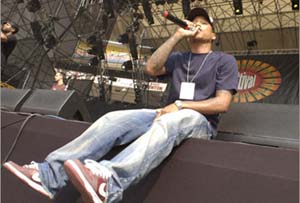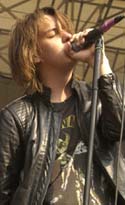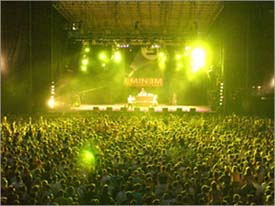|
Memorial Day weekend,
the traditional start of summer, means one thing to
the student, another to the worker, and quite another
to the boss. Yet for all of them it brings hope. The promise,
if nothing else, of a well-earned vacation. For thousands
of mid-Atlantic music fans, a big part of the ritual has,
for the past thirteen years, been the annual HFStival.
Sponsored by Washington, D.C., based WHFS FM, the festival
is a two-day affair featuring virtually every act popular
with the 14-30 age group during the previous year. Past
performers have included Pavement, Stone Temple Pilots,
Stereo M.C.’s, and the Rollins Band. This year’s
lineup: Eminem, Papa Roach, Sum 41, Hoobastank, and the
Strokes, among others.
There’s something
to be said for the sheer volume of top-tier acts the festival
attracts. While based in D.C., it is clearly a national
event, one that usually warrants coverage on MTV and in
magazines like SPIN. While tickets, at $39 per
day, are not cheap, they are also not ridiculous. Break
it down per-band and it becomes justifiable. It’s
a solid weekend of fun in the sun... except.
Altamont and Woodstock
’99 proved how truly dangerous it can be to gather
a large group of people and turn them loose in a confined
space. That would seem to go without saying, yet there
is never a shortage of wolves willing to ignore the lessons
of the past. The HFStival is notable in this context for
two things that it perfectly represents in microcosm:
the extent to which "the market" shapes real experience,
and the inevitable, ugly consequences.
 |
|
N.E.R.D.
|
There is no benevolent
urge associated with the production of the HFStival. It’s
hard to say when it happened, but at some recent point
advertisers realized that their message was not being
received through the conventional channels. So now there
is no longer a target "audience," there is a target "lifestyle."
As in: "The SKYY Blue drinker is educated, active, and
fun. She wants the good things in life, but doesn’t
want to stress about finding them. When she goes out she’s
looking to enjoy a lively time with good friends... and
along the way, maybe make some new ones." WHFS
has an audience, and that audience is basically young
white people with disposable income. But that audience
doesn’t want to be seen in such crass, demographic
terms. Having been raised on media, they’re sensitive
to being pigeonholed, or at least obviously so. They want
to see themselves as part of something larger.
Enter the HFStival. On
the one hand it makes no sense for the Strokes and Eminem
to share a bill. The two acts have nothing in common musically
and no shared background. Theoretically, they should have
no shared audience. So one could see the HFStival as a
triumph of diversity wherein disparate elements are brought
together to bond, mystically, through the power of music.
In fact, the music is a nonessential element of the production.
Bands play as background to the brand, as a soundtrack
to the lifestyle. Who they are, where they came from,
and why they sound the way they do is wholly unimportant.
What matters is that they have been shown, through studious
market research, to appeal to the WHFS audience (and,
indeed, to the audience of every other station in the
country with an "alternative/rock" playlist). Putting
them together ensures turnout, which ensures street-level
(and street-credible) exposure for the sponsors.
 |
|
The
Strokes
|
These ingredients do not
automatically add up to a bad experience. The selling
of products and ideas is, on some level, at the heart
of all artistic expression. There’s nothing inherently
wrong with putting it all together and making some money
at the same time. The bands, at least the ones with anything
interesting to say, seemed to recognize this. The Strokes,
N.E.R.D., Black Rebel Motorcycle Club, and Eminem all
played well, and there was nothing compromising in their
performances. Indeed, the Strokes (who brought with them
a reputation of having a bland live show) were quite amazing.
Ditto N.E.R.D., who deserve far more attention than they’re
getting. Their music, which proves beyond a doubt that
a live band will always be better than a DJ, will someday
be seen as having been the future all along.
But there was a wall
between artist and audience that couldn’t be broken.
Perhaps it was because it’s hard to enjoy a stadium
show unless you’re right up front, but that wasn’t
all. The crowd, as a whole, seemed as crassly uninterested
in the music as the organizers. Many of the attendees
seemed to be there for exactly the reason that WHFS wanted
them there—to live the experience, to buy the memento,
and to be able to say they had been there. During Black
Rebel Motorcycle Club’s performance several mosh
pits sprang up. During the Strokes, the only truly loud
applause came during the first notes of "Last Nite," their
hit single. And during every set great attention was paid
to the line of bikini-clad women carrying Bacardi placards
as they patrolled the crowd, tossing out Bacardi beach
balls for all to enjoy.
This is to say nothing
of the midway-esque outside stage area. Extreme sports
(rock climbing, anyone?), cell phones, hemp, etc. were
well represented with booth space. A variety of second-tier
national and local acts played there, and were summarily
ignored in favor of the vendors hawking their wares.
There was a heavy-handedness
to the whole affair that could only go one way. By the
end of the day there were more fights than one would care
to count, and 30 people were injured, two critically,
during Eminem’s performance as the crowd surged forward.
When he stopped playing and implored the crowd to back
up, it took 20 minutes to accomplish the goal. They weren’t
there for him, they were there for themselves. They wanted
more, and wanted it better, and wouldn’t hesitate
to do what it took to get it. After a long day of soaking
up an atmosphere of controlled freedom, they did the only
thing that made sense: they kept it up, right to the end.
 |
|
Eminem
|
This same scene will repeat
countless times as the summer wears on. There’s the
Warped tour, there’s the Ozzfest, and there are other
one-time-only radio station festivals, notably Los Angeles’
KROQ festival. It’s safe to say that the injuries
will mount and the money will be collected, and the whole
thing will go down as a success because it doesn’t
matter if a few kids get hurt. Next summer the pattern
will repeat, except that the bands will be the same. Whatever
trend breaks big this winter will become the new reason,
and the same kids will turn out again after tossing out
their Hoobastank T-shirts and laughing about what a great
time last year’s festival was.
The following words—as
concise and bizarre a summation of the weekend as one
could imagine—come from the lead singer of SEV, a
fourth-rate rap/rock/metal hybrid act whose time has probably
already passed:
"You motherfuckers
are real, and it’s fuckin’ obvious."
|